Strategic Management Assignment: Strategic Report & Organisational Redesigning for Jollibee
Question
Task:
Strategic Management Assignment Task 1: Strategic Report
“Experts have opined for decades on the reasons behind the spectacular failure rates of strategy execution. In 2016, it was estimated that 67% of well-formulated strategies failed due to poor execution. There are many explanations for this abysmal failure rate, but a 10-year longitudinal study on executive leadership conducted by my firm showed one clear reason. A full 61% of executives told us they were not prepared for the strategic challenges they faced upon being appointed to senior leadership roles. It’s no surprise, then, that 50%-60% of executive fail within the first 18 months of being promoted or hired.”
The above extract has been taken from the article published in Harvard Business Review titled “Executives fail to execute strategy because they are too internally focused” by Ron Carucci.
In the context of the above extract, learners should write a strategic report to help save a company that is on the ropes: it is losing money, it is losing market share, and it seems to have lost its identity. Unless you intervene, the company will have to fold. The company should be real company that is encountering the above-mentioned scenario.
Your first assignment is to help save a company that is on the ropes.
Strategic Management Assignment Task 2: Organizational redesign
For the above strategy how would you restructure the organisation which enables it to overcome the challenges and improve innovation, collaboration and coordination?
Develop and submit a strategic restructuring plan. Include current organisation charts and proposed organizational charts and describe the changes in detail.
Answer
Strategic Management Assignment Task 1: Strategic Report on Jollibee
1. Executive Summary and Introduction
Contemporary businesses face intense competition in the external environment. They are affected by various market changes and other factors impacting their business threats either through opportunities or threats. The rapid growth in globalization and increasing technological advances have increased these challenges for the companies. However, it has been observed that businesses fail to effectively execute their strategies for operating in the market (Sull, Homkes and Sull, 2015). They seldom understand the importance of strategic management in the organizations that help in achieving the desired objectives. The report aims to save Jollibee, a fast food restaurant from failing in the market. For this purpose, it has analysed various strategic relationships, evaluated the impact of external factors on the firm, developed suitable strategy for facing challenges and meeting objectives. The report has further focused on analysing innovation and change strategy, developed an implementation plan for proposed strategy and provided some recommendations to Jollibee.
2. Relationships between strategy, stakeholder expectations and organizational performance
It is essential for Jollibee to understand the relationships existing amongst strategy, stakeholder expectations and its organizational performance. These elements are interrelated with each other, which ultimately affects the business reputation and competitive advantage of the firm. In this regard, stakeholder theory of strategic management can be undertaken for gaining detailed insight into these relationships (Taghian, D’Souza and Polonsky, 2015). Based on this theory, there exists two types of stakeholders for Jollibee that it needs to acknowledge for understanding their expectations, namely, internal and external stakeholders. Internal stakeholders consist of those groups associated directly with the business operations and include managers, employees and labour unions. On the other hand, external stakeholders are the ones outside the company but are affected by the organizational activities (Taghian, D’Souza and Polonsky, 2015). These include public stakeholders, local residents, media, government and regulatory agencies and communities. This theory has been considered for enabling Jollibee to differentiate between its stakeholders, comprehend their expectations and accordingly, formulate organizational strategies for ensuring improved business performance. This is because these stakeholders can determine the success or survival of the business based on its ability in meeting their expectations (Taghian, D’Souza and Polonsky, 2015).
Fig 1: Types of Stakeholders
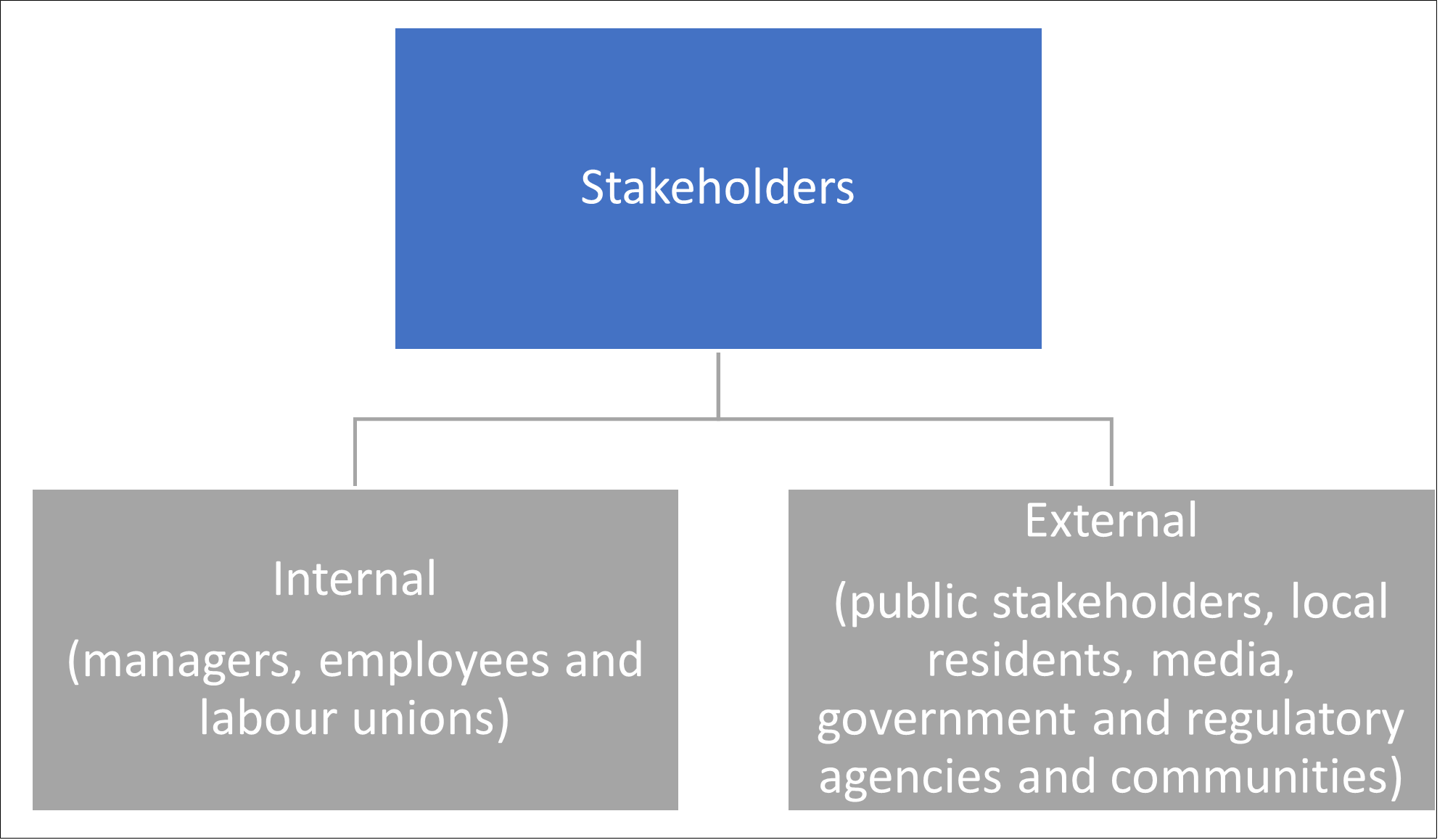
Both internal and external stakeholders have expectations that Jollibee must meet with its business strategy. For example, shareholders have expectations of high profits and dividends, good returns on investments and rising share prices. On the other hand, customers prefer high-quality of products at affordable prices (Darškuvien? and Bendoraitien?, 2014). While local communities expect the company to address various social and environmental issues. This shows that the objective of a business extends beyond generating profits for its shareholders and must focus on delivering range of benefits as expected by different stakeholders. Thus, the organization acts as a nexus of relationships amongst various internal and external stakeholders (Darškuvien? and Bendoraitien?, 2014). Jollibee might face issues in managing different expectations of different stakeholders. However, it should focus on fulfilling its corporate social responsibilities in the three aspects of economic, social and environmental. This helps in meeting stakeholders’ expectations by protecting the interests of each group. Achieving these CSR responsibilities help in improving the perception about the company across the different stakeholder groups (Brower and Mahajan, 2013). Here, the company focuses on reducing any strategy related issues for fulfilling its economic, social and environmental responsibilities. This helps in generating positive impact of CSR on the corporate reputation of the company. Thus, Jollibee needs to meet various stakeholder expectations with proper strategy formulation and implementation in achieving its CSR objectives.
Enhanced corporate reputation and fulfilment of stakeholder expectations can improve the business performance of Jollibee. With such brand reputation, the company will be able to attract more customers for buying its products and services (Fernando and Lawrence, 2014). Furthermore, positive brand image will enable it to capture new market share because its acceptability amongst general public, media agencies and local communities will improve with the achievement of economic, social and environmental responsibilities. Besides, CSR has emerged as one of the corporate practices alongside being stakeholders’ expectations for evaluating the business activities and operations of a company. Improvement in ethical conduct of Jollibee will enable it to regain not only customers’ trust and confidence in its business practices, but also amongst other stakeholders in the market (Brower and Mahajan, 2013). Here, the firm can further incorporate CSR as strategic choices for meeting stakeholders’ expectations in its business strategy and linking to its brand personality. Such CSR activities can be helpful in influencing both internal and external stakeholders, thereby leading to improved business performance.
3. Impact of external factors on strategic management
There exist various factors in the external environment, such as, political, social, technological, economic, legal, environmental and others that can impact the strategic management of Jollibee (Çitilci and Akbal?k, 2020). This makes it essential for the fast-food restaurant to analyse these factors for identifying possible opportunities and threats that might arise from them.
Economic- Economic analysis of the international market takes into consideration various aspects and how each of these areas can affect the strategic management of a company. These generally include economic growth or downturn, interest rates, exchange rates, inflation, unemployment and others.
Fig 2: Global inflation rate from 2016 to 2026
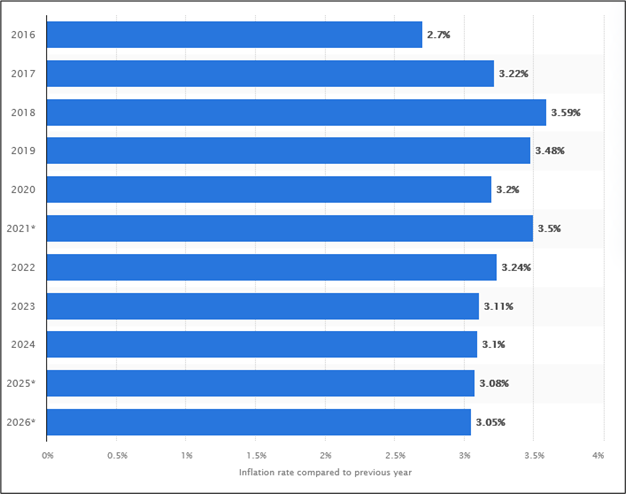
(Source: O’Neill, 2021a)
The inflation rate in US, Europe and other emerging markets still continues to grow alongside the bullwhip effect contributing towards the same (Kalish, 2021). This has been increasing the prices of goods and services across the global economy, which is ultimately impact the sales of companies like Jollibee.
Fig 3: Global gross domestic product (GDP) at current prices from 1985 to 2026
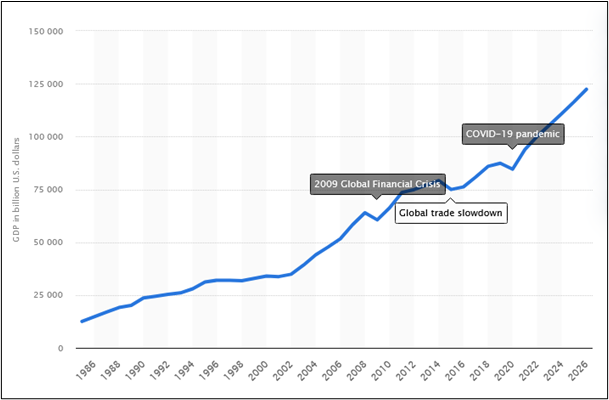
(Source: O’Neill, 2021b)
However, despite these difficulties, the global economy is expected to grow at a projected rate of 6% in 2021 and 4.9% in 2022 (IMF, 2021). The pandemic developments and changes in policy support in advanced economies are projected to contribute towards this growth. On the other hand, the developing economies might not experience significant economic growth immediately because of the resurging pandemic. Thus, the outbreak of the COVID-19 pandemic has generated catastrophic effects on the global economy affecting major nations such as the US, UK, Japan and others (Kalish, 2021). Other developing countries have also been facing the aftermath of this crisis alongside the developed nations. This has made it difficult for companies like Jollibee in retaining their normal sales and revenues as customers’ purchasing power has decreased because of the economic downturn.
Political- Political factors also play an important role in determining strategies undertaken in an organization. These provide how government policies and actions intervene in the economy, thereby affecting the business operations (Menet, 2016). Various political factors include trade restrictions, tariffs, bureaucracy and tax policies. Thus, political stability is essential in a country for the companies to achieve their strategies.
The outbreak of the pandemic in 2020 and the recovery of nations from its aftermath have changed the global political outlook in 2021 (Graham-Harrison, et al., 2021). China has been able to quickly recover and strike a trade deal with EU that indicates its attractiveness towards global investors. The US government has been facing a number of challenges and issues related to the pandemic, which has pointed out its fragile democracy. While Europe has been treading carefully, new political voices have emerged from Africa (Graham-Harrison, et al., 2021). Thus, these issues have put the government under pressure, thereby changing various policies and affecting the strategic management of businesses.
Fig 4: Global political risk reached a multiyear high in 2020
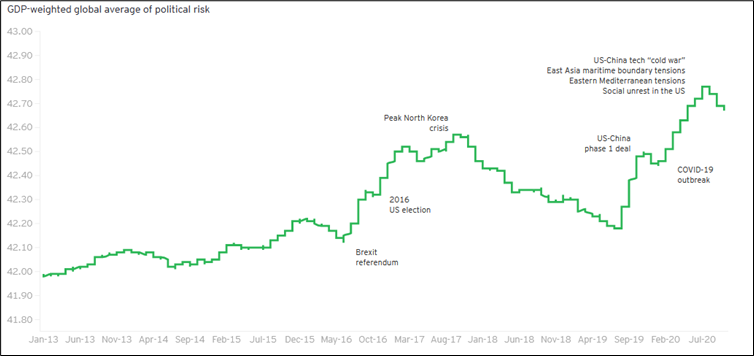
(Source: McCaffrey and Cline, 2020)
Furthermore, the pandemic has led to increase in political risks across the globe generating uncertainties in the political environment that businesses face. The changing policies of the governments and innovating them in real-time across all countries have been challenging the strategy development and execution of the companies (McCaffrey and Cline, 2020). This makes it essential for Jollibee to dynamically evaluate political risks for identifying potential opportunities and challenges.
Sociocultural- The outbreak of the COVID-19 pandemic has increased the divide between rich and poor. This has set back some countries in their attempt to reduce poverty for decades (Marsh, 2021). Furthermore, there has been rising costs of water access, food security and energy, which have given rise to growing nationalism and civil unrest in countries. On the other hand, cultural trends are expected to change consumer behaviours that Jollibee must consider for its strategy formulation (Bakhtiari, 2021). These include digital divide, brand nations, human brands, and others.
4. Strategy for facing challenges and meeting objectives
Based on the analysis of economic, political and cultural factors, a strategic tool can be used for identifying the best suitable strategy for Jollibee going forward in the coming years. In this regard, the BCG Growth-Share Matrix can be helpful for developing an effective strategy for the company (Ry?ca, 2016). This matrix is based on the different combinations of market growth and market share. Here, the market growth indicates industry attractiveness while relative market share serves as the competitive advantage for the company.
Fig 5: BCG Growth-Share Matrix
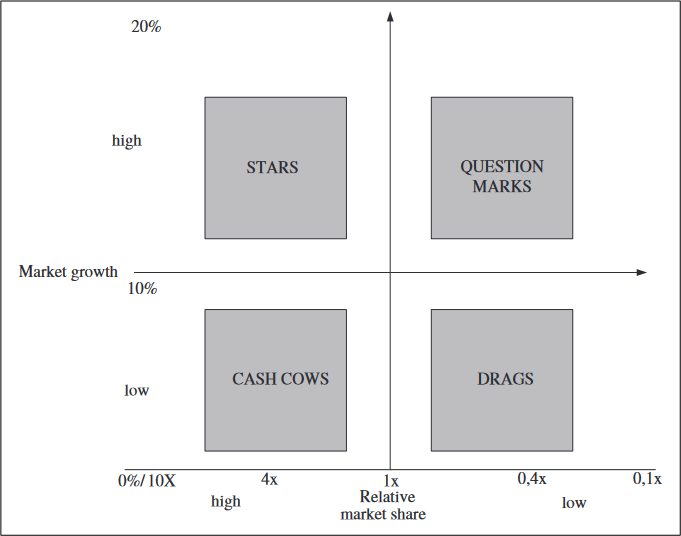
(Source: Ry?ca, 2016)
The four quadrants in the matrix are cash cows, stars, question mark and dogs. Jollibee falls in the question mark quadrant with small market share in the highly growing fast-food industry. the restaurant needs sufficient resources for gaining larger market share in the fast-food market that is dominated by global players such as Starbucks, McDonald’s, KFC, Burger King, Subway and others. The restaurant has growth potential with requirement of large amounts of cash for capturing market share (Madsen, 2017). This is because it is incapable of generating such cash from its low market share as compared to other brands in the global fast-food industry. Furthermore, Jollibee might either become a star or a dog depending upon its strategy formulation and implementation. With effective strategies, the company will enhance its potential of gaining market sharing and becoming a start, eventually followed by becoming a cash cow with the slowed down growth of the market. However, it might not be successful in emerging as the market leader with ineffective strategies (Madsen, 2017). In this regard, Jollibee might degenerate into a dog position with the decline in market growth of fast-food industry despite years of consuming cash. This makes it essential for the company to analyse its potential effectively for determining the effectiveness of the investment.
Jollibee needs to undertake a market development strategy for ensuring its growth and development in the coming years. This involves venturing into new markets with its existing food products and services for catering to different customers. In this regard, the company can enter new markets with the help of various ways (Larrain and Urzúa, 2016). One of the most significant ways of market development for Jollibee will be undertaking geographical expansion by research markets that are suitable for its growth and development. Here, it can consider either brick-and-mortar stores or online business. However, the restaurant must analyse if it has enough resources for expansion, product viability, value of the market and saturation of the potential market. Furthermore, it can consider the option of franchising by giving business owners in the new markets with the right of using its brand name and trademarks for selling the products (Perrigot and Pénard, 2013). This is a less risky strategy where the franchisee will be required to pay an upfront fee to Jollibee for obtaining the rights of operating its business. Besides, the restaurant can suggest new flavours or variations in its existing food items for promoting them to the customers in the new markets. Here, it can undertake survey for identifying innovative ways to add extra interest towards the existing food items in the menu. Lastly, there are other market development strategies for Jollibee. It can adopt competitive pricing structures for the new markets by offering them with discounts, undertake intensive distribution channels for reaching large number of customers, increase brand awareness through advertising and promotion, target different demographic segments or consider modifying the food items based on customers’ preferences.
5. Business Strategy that Encourages and Supports Innovation and Change
Any business organization, especially those who need to recover their market position like Jollibee, need to implement business policies and need to adopt business strategies that support and encourage innovation and change. Often innovation is considered through the perspective of creating innovative services or products. However, it is also about changing the way an organization performs its business through improved industry culture, using upgraded technologies, recovery strategy and meeting the customer expectations.
Recovery Strategy
In order to restore business operations, Jollibee comes with value meals and fast delivery facilities. This recovery strategy ensures more customers and thus more profit.
Innovation as Core Value
As stated by Kremer, Villamor and Aguinis, (2019), organizations core value must be innovation in order to gain competitive success through upholding the brand name as the provider of innovative and unique products. As Jollibee is a famous fast-food joint of Philippines, it must offer local flavours and hybrid dishes to its foreign customers.
Hiring Employees with Different Ability
According to Stojcic, Hashi and Orlic, (2018), it is important to hire efficient and experienced employees who have visions that are aligned with visions of innovation and change. As Jollibee is a multinational fast-food joint, its chefs play the major role to gain competitive success. Jollibee chefs offers tasty and quality foods to its customers. With their innovative food menu, Jollibee has initiated food tourism in Philippines. Hiring chefs from diverse background helps Jollibee to make innovative cuisines.
Supervising Raw Materials
In order to maintain the quality, Jollibee supervises its suppliers. Even it monitors the supplier which is based in Mainland China and supplies chicken for Jollibee.
Providing Time and Space to Innovate
In order to support innovation, Jollibee provides enough time and opportunity to share the ideas and suggestions regarding how to run the business and how to gain sustainable competitive success (Müller, Buliga and Voigt, 2021). It allows its chefs to conduct meeting over producing innovative and tasty foods to attract more food lovers to their outlets.
Encouragement
Jollibee encourages its employees and chefs to bring unique and innovative ideas, provides positive feedbacks frequently and most importantly allow them job swaps. These approaches establish employees’ loyalty and dedication.
Invest in Resources
As stated by Müller, Buliga and Voigt, (2021), in order to meet customers’ demand and gain profit, Jollibee conducts relevant professional trainings for its employees. It often rewards its chefs and teams to improve their dedication to make something innovative.
Evaluating Strategies Developed against Competing Strategies to Gain Organizational Success
With the aim to beat the pivotal competitors, often organizational focus revolves around understanding customers’ negative feedbacks, pricing strategies and identifying competitive market. Conducting open-ended survey with the target customers and know what exactly they want to have, is a strategy that can beat the competition. However, instead of applying such strategy, Jollibee focuses on preparing quality hybrid cuisines to satisfy its customers in the Middle East, Southeast Asia, East Asia, North America and Europe. Conventional pricing strategy suggests to fix acceptable price of each product. However, Jollibee Jollibee applied psychological pricing strategy and added more value to some of its special product lines to showcase them as their premium dishes (Annushkina and Regazzo, 2020). This pricing strategy attracts many customers. Even Jollibee’s smart branding strategy through offering innovative new products, superior menu line-up and efficient manufacturing facilities brings success to it. Instead of maintaining only its signature dishes like other competitors like McDonalds or KFC, Jollibee identify a niche-market (focus strategy) to serve innovative and hybrid food items. According to Torioetal., (2021), Jollibee has come out of box and has joined the food tourism campaign, “Eats. More fun in the Philippines” launched by Department of Tourism (DOT) in Philipines. Rather only on focusing on the outlet performances, Jollibee adopted this unique strategy. This idea made Philippines as a great food destination and increased the number of tourists who are not only coming to Philippines for sight-seeing, but to discover innovative cuisines by Jollibee.
6. Implementation Plan for Strategies to Meet Major Stakeholder Expectations
According to Harvard Business Review, 67% of the strategies failed due to poor execution as executives are too internally focused and are unable to think or do out of the box and implement innovative ideas quickly. Therefore, in order to implement business strategies, Jollibee needs to set strategies, fix tactics, understand ongoing planning and measure risks, set targets and finally execute the strategies. Above discussed strategies are easy to implement and are able to satisfy the major stakeholders of Jollibee.
Shareholders and Owners
Major shareholders and co-owners expect that their opinions will be valued and they will get enough return profits through hassle-free process. Jollibee accepted the suggestion of imposing premium cost for some of its food-lines, which increased its profitability and thus it abled to provide its shareholders the expected annual dividend by cash based on the yearly profit.
Implementing modern technology is also beneficial for the major shareholders as technology can run modern business smoothly and can protect the confidential data from cyber attackers. Jollibee already uses technology-based products and services such as Google Analytics, jQuery and HTML5. However, focusing on more personalization technologies would be potential as these are in high demand in this new era of technology (Zinkin, 2020). For instance, McDonalds uses Dynamic Yields, provides facilities of mobile order and pay. Jollibee’s self-order kiosks in outlets of several cities are like their secret weapon.
Customers
Customers are the most important stakeholders of any food chain. In order to meet the expectations of the customers, some strategies were developed for Jollibee. For instance, it was suggested to launch self-order kiosks, phone pay and order, fast delivery system and to offer more combo meals. All these strategies have already initiated and it has been noticed that customers such as office employees and families with medium income have been satisfied with Jollibee’s various types of combo meals. According to Matejowsky, (2020), even, after initiating food tourism with the collaboration of Department of Tourism, tourists who till now came to explore tourist-spots only, are now also coming to discover the authentic flavour of the cuisines offered by Jollibee. Customers are also satisfied with the quality of Jollibee’s chicken which is offered at a reasonable price.
Suppliers
Jollibee’s whole production depends on its suppliers. According to Poblador, (2018), Daily raw materials are shipped into Jollibee’s warehouse for inspection and production. Jollibee itself regulates all the ingredients. Even the exclusive supplier from Mainland China, which provides chicken to Jollibee is also regulated by Jollibee. As poor quality or shortage of raw material can result a disaster for Jollibee which also affects its suppliers financially, so Jollibee itself inspects and regulates the raw ingredients. Thus, this strategy of supervising raw materials regularly not only helps the company but also indirectly helps the suppliers to maintain their quality.
Financier
In order to ensure the security of any loan taken by the Jollibee, financers such as financial institutions, insurance companies and banks are interested in Jollibee’s market growth and financial condition. As the bankers or the financiers are keen to minimize the risk of non-paid interest by the company, Jollibee’s business growth assures them also.
According to Do, Herat and Kaparaju, (2021), Vietnamese investors even, its government has major role to play in Jollibee’s business as they want to mitigate their unemployment issue. As a business strategy, Jollibee obeys all the policies and regulation to do business over Vietnam, which helps the company to grow across the border and the nation to create employment.
Foreign Government
Having its origin in Philippines, Jollibee operates in Europe, Middle East, Eastern Asia, Vietnam and in many more countries. In order to satisfy these governments of various countries having different regulations, policies and local cultures, Jollibee maintains every single yet different polices and regulations related to trade. Even in order to maintain social stability, it offers different food menus according to the cultures and religions of different countries and regions. Though this approach is considered as Jollibee’s business strategy, yet it helps to meet the expectations of the stakeholders such as customers and governments.
7. Recommendation and Conclusion
Jollibee is as Philippines based fast food chain which is currently operating in Europe, the middle-east countries, Eastern Asia and South Asian countries. Jollibee uses innovative strategies along with conventional business strategies that helps it to beat competitive market. Every strategy chosen by Jollibee is to support and encourage innovation and change.
However, there are some issues and challenges that create obstacles for Jollibee to get ultimate organizational goals. Though, it supervises all the raw materials coming from its suppliers, still Jollibee must regulate strictly while it delivers final food products to its customers. For instance, a Jollibee customer complained of receiving a delivery of “deep fried towel” instead of fried chicken. Jollibee was forced to close one of its outlets in Philippines, due to this incident.
Though some of Jollibee’s combo meals are permittable to the people of middle-income group, yet it must adopt bundle pricing strategy where it would provide meals along with other products like cold drinks or milk shake within a reasonable price range.
It is recommended to Jollibee to conduct corporate social responsibility (CSR) initiatives regularly through Jollibee Group Foundation (JGF) to uplift marginalized sectors of the country. This social approach uplifts the brand name and increases the business.
Strategic Management Assignment Task 2: Organizational Redesign
1. Organizational Restructuring
According to Joseph and Gaba (2020), organizational restructuring refers to the process in which the unsatisfying status quo of an organization is addressed in the ever-changing market condition. The organizational restructuring of Jollibee should be based on adequate strategic planning. This strategic planning will be boosted by innovation. The restructuring or organizational redesign could be a tactics or strategic reaction to the unexpected circumstances. After the failure of Jollibee, its recovery in China, could be addressed through effective organizational redesigning.
Jollibee as a multinational company from Philippines, has been operating successfully in the fast food industry. The chain of restaurants is owned by the Jollibee Foods Corporation or JFC. The company has been profitably running more than 5800 outlets across 33 nations. However, it is not easy to achieve success in every market. The company failed massively in the Chinese market. Though many are of the view that the company had not failed but it is the early start of Jollibee in the China market. The company would need to strengthen its footing in the market of China. The company’s products have not been able to make its market in China. The taste of the fast food items on their menu are not suitable for the taste of the local people in China. Thus, the company has to adjust and amend its menu to suit the taste buds of the Chinese population.
Jollibee has its operations in many countries across the world. The company has been expanding to new markets and is still looking for further scope of expansion. In order to internationalize the business, Jollibee has to formulate effective policies keeping the business environment in mind. At present Jollibee is operating in thirty-three nations. However, the company is wanting to achieve faster return on investment. To stabilize in China and run its business successfully, the company has to analyze the business environment and the competitive scenario of the market.
As stated by Mo?teanu (2020), the organizational structure of Jollibee defines the activity management and how the various tasks are delegated among the staff. The organizational coordination of the company is established through its line organizational structure. The organizational chart shows the way supervision is done across the organisation. The hierarchy of the organization is displayed in the chart. The roles and responsibilities and the power hierarchy of Jollibee is clear from the organizational structure. The organizational structure was designed with the intention of integrating the individual efforts into team efforts, satisfying the organizational goal of satisfying the wants of the customers from various walks of life and varying age groups (Uhl-Bien and Arena, 2018). The success of Jollibee to a great extent is dependent on its organizational structure.
Jollibee currently has a line organizational structure. The various levels of the organization have a vertical and direct relationship. The line structure follows a proper chain for achieving the organizational goals. The authorities, roles, responsibilities are clearly defined in this structure. This facilitates faster decision making and enhances accountability. The closeness among the workforce is established in line organizational structure.
Line Organizational Structure
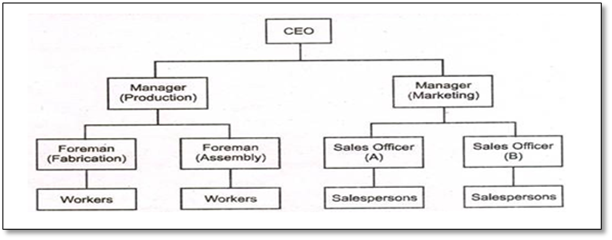
(Source: Masud et al, 2019)
However, after the failure of Jollibee in China, the need of a different organizational structure was realized. The line organizational structure suffered due to lack of specialization. The team members and managers of each department were only skilled and concerned to perform the tasks related to their own departments and were least aware of the entire organizational operations (Masud et al, 2019).
The matrix organizational structure would be effective for Jollibee, facilitating recovery. In this structure, the hierarchy is established in a horizontal pattern. The matrix structure would be useful for Jollibee as it would foster achievement of the organizational goals from various areas of the company. The decentralized decision making is an advantage of this organizational structure. This facilitates flexible resource allocation and utilization. The support system can also be used efficiently and effectively. This would help Jollibee to meet the organizational objective of serving people from various walks of life. The organization would accommodate the required changes to suit the needs of the different markets (Srinivasan and Swink, 2018).
Matrix Organizational Structure
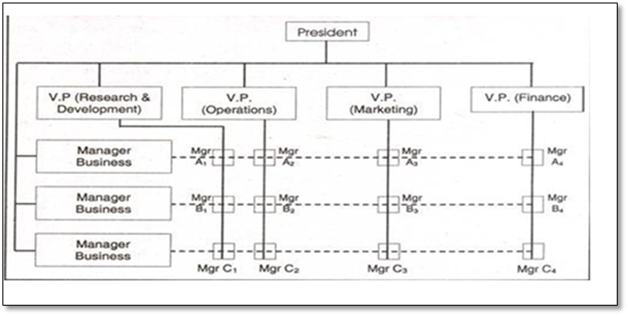
(Source: Srinivasan and Swink, 2018)
The organizational restructuring is needed for Jollibee because it would increase the efficiency of the management teams of the company. The effectiveness of the operations of Jollibee will be enhanced through change in organizational structure.
As per Jollibee (2020), the objective of Jollibee is developing, operating and franchising its fast food service restaurant brand. To attain this expansion and establishment of the brand, worldwide, Jollibee needs an appropriate organizational structure which would support its organizational objectives. The company offers various delicious and affordable dishes to meet the food requirements of the people of different countries. However, the failure to meet the taste requirements of the customers has led to the company’s downfall in few nations like China. The organizational structure of the company has to be such that it accommodates the changes required to adjust in a new market environment.
2. Evaluation of Restructure Plan
According to Auchter et al (2018), the matrix organizational structure will address the problem of Jollibee. The main cause of failure of Jollibee was that they failed to understand the tastes and preferences of the people of China. They could not read the minds and follow the choices of the Chinese people. They failed to emerge as a preferred fast food brand in Chinese market. The line organizational structure did not support flexible supply chain management. The decision making was constricted. However, under matrix organizational structure the support system of Jollibee will facilitate better resource allocation. The decision making will be situation driven, decentralized rather than centralized. This fosters better decision making and goal achievement. For companies like Jollibee which are trying to expand and grow, matrix organizational structure is highly effective. The decision-making power being decentralized, facilitates better coordination at every level of the organization. As Jollibee originates in Philippines and has expanded to other countries which have varied cultures, they need to understand their cultures and preferences. Expansion to other nations implies changes in business environment. To incorporate and adapt to these rapid changes, the matrix organizational structure is important. Jollibee will be able to plan their recovery strategy through matrix organizational structure.
As the company, Jollibee is expanding and the number of employees is expected to increase with time, the company should follow a matrix organizational structure. The matrix organizational structure of Jollibee will enable better division of work (Timinsky, A. and Marushchak, 2018). This organizational structure also abides by the administrative theory of management. The employees can be easily divided into small teams with a specialist in each team. The various aspects of management and team coordination are well organized under the matrix organizational structure. Through matrix organizational structure Jollibee can implement effective planning, better combining, efficient organizing, appropriate training, strong coordinating and commanding.
However, there could be various negative consequences and issues while adopting a matrix organizational structure. The managerial roles under the matrix organizational structure might not be defined clearly. This could lead to confusion regarding the roles and responsibilities. Moreover, the team roles might also be unclear under this form of organizational structure. This could disrupt smooth team operations. In case of line organizational structure, the decision-making process is fast (Yousef, 2017). On the contrary, the decision making under matrix organizational structure is slowed down due to its decentralized nature. The teams and managers could be overloaded with huge work burden. Under the matrix organizational structure, the performance of the employees is difficult to measure and evaluate.
Jollibee will definitely have several benefits from the adoption of matrix organizational structure. But they would also have to deal with the negative consequences. Few of these issues or negative consequences include conflict of the potential of the employees between priorities and managers. Furthermore, there could be confusion in communication under matrix organizational structure. Besides, the lack of adequate clarity regarding what is whose responsibility leads to problem in performance evaluation. The lack of determination of job role and responsibility could further result in inappropriate professional coaching and development. This would hamper the recovery of the business of Jollibee after the failure. Moreover, the capability of the individuals is reduced under the matrix organizational structure. The participants or employees are stretched and occupied in several initiatives. The effectiveness of the organization could be further reduced among the functional teams which have been working together for quite some time (Safina et al, 2019). The loss of the team learning and organizational learning could result from matrix organizational structure as the individual employees or managers are involved in a specific task for a short span.
The challenges like conflicts, confusion and lack of clarity of matrix organizational structure could be overcome by clearly defining the project charter. The employees should be given clear instructions agreed upon by the organization’s managers. Besides, the members working on a particular project should be thoroughly screened so that it is assured that they can handle the given responsibilities (Mo?teanu, 2020). With the increase in work volume, many employees or managers find it difficult to cope with the work load. Thus, the members being assigned to a project should be competent enough. The matrix organizational structure could have different forms. The appropriateness of the form of matrix used should be analyzed keeping the business activity in mind. The capabilities of the organization, Jollibee and team members need to be considered. The documentation for all the operations of the organization should be thorough, all throughout the undertaken project.
Reference list
Annushkina, O.E. and Regazzo, A., 2020. Is Your Business Reaching Its Full Scale on Global Markets?. In The Art of Going Global (pp. 1-20). Palgrave Macmillan, Cham.
Auchter, A.M., Mejia, M.H., Heyser, C.J., Shilling, P.D., Jernigan, T.L., Brown, S.A., Tapert, S.F. and Dowling, G.J., 2018. A description of the ABCD organizational structure and communication framework. Developmental cognitive neuroscience, 32, pp.8-15.
Bakhtiari, K., 2021. Cultural Trends That Will Shape Consumer Behaviour In 2021 And Beyond. [online] Forbes. Available at: < https://www.forbes.com/sites/kianbakhtiari/2021/02/26/cultural-trends-that-will-shape-consumer-behavior-in-2021-and-beyond/?sh=64c2ca656d9c > (Accessed 17 December 2021)
Brower, J. and Mahajan, V., 2013. Driven to be good: A stakeholder theory perspective on the drivers of corporate social performance. Journal of business ethics, 117(2), pp.313-331.
Çitilci, T. and Akbal?k, M., 2020. The Importance of PESTEL Analysis for Environmental Scanning Process. In Handbook of Research on Decision-Making Techniques in Financial Marketing (pp. 336-357). IGI Global.
Darškuvien?, V. and Bendoraitien?, E., 2014. Stakeholder expectations and influence on company decisions. Taikomoji ekonomika: sisteminiai tyrimai, 8(2), pp.83-96.
Do, T.K.C., Herat, S. and Kaparaju, P., 2021. The Current Use and Management of Single-Use Items (SUIs) in the Fast Food Industry in Ho Chi Minh City, Vietnam. Nature Environment & Pollution Technology, 20(3).
Fernando, S. and Lawrence, S., 2014. A theoretical framework for CSR practices: Integrating legitimacy theory, stakeholder theory and institutional theory. Journal of Theoretical Accounting Research, 10(1), pp.149-178.
Graham-Harrison, E., Ellis-Petersen, H., Smith, D., Davidson, H., Henley, J., Burke, J., Roth, A., Holmes, O., Phillips, T. and Readfearn, G., 2021. The world in 2021 – how global politics will change this year. [online] The Guardian. Available at: < https://www.theguardian.com/world/2021/jan/03/the-world-in-2021-how-global-politics-will-change-this-year > (Accessed 17 December 2021)
Harvard Business Review. 2021. Executives Fail to Execute Strategy Because They’re Too Internally Focused. [online] Available at:
IMF, 2021. World Economic Outlook. [online] Available at: < https://www.imf.org/en/Publications/WEO > (Accessed 17 December 2021)
Jollibee. 2021. About Us. Available at https://www.jollibeefoods.com/pages/about-us. [Accessed on 17th December, 2021]
Joseph, J. and Gaba, V., 2020. Organizational structure, information processing, and decision-making: a retrospective and road map for research. Academy of Management Annals, 14(1), pp.267-302.
Kalish, I., 2021. Weekly global economic update. [online] Deloitte. Available at: < https://www2.deloitte.com/us/en/insights/economy/global-economic-outlook/weekly-update.html > (Accessed 17 December 2021)
Kremer, H., Villamor, I. and Aguinis, H., 2019. Innovation leadership: Best-practice recommendations for promoting employee creativity, voice, and knowledge sharing. Strategic management assignment Business Horizons, 62(1), pp.65-74.
Larrain, B. and Urzúa I, F., 2016. Do business groups change with market development?. Journal of Economics & Management Strategy, 25(3), pp.750-784.
Madsen, D.O., 2017. Not dead yet: the rise, fall and persistence of the BCG Matrix. Problems and Perspectives in Management, 15(1), pp.19-34.
Marsh, 2021. Political Risk Map 2021: Pandemic Recovery Complicates Risks. [online] Available at: < https://www.marsh.com/lt/en/services/political-risk/insights/political-risk-map-2021.html > (Accessed 17 December 2021)
Masud, M., Kaium, A., Rashid, M., Ur, H., Khan, T., Bae, S.M. and Kim, J.D., 2019. Organizational strategy and corporate social responsibility: The mediating effect of triple bottom line. International journal of environmental research and public health, 16(22), p.4559.
Matejowsky, T., 2020. What’s all the buzz about? Jollibee, diaspora marketing, and next-stage fast food globalization. Food and Foodways, 28(4), pp.274-296.
McCaffrey, C. R. and Cline, M., 2020. What elevated levels of political risk mean for business in 2021. [online] EY. Available at: < https://www.ey.com/en_gl/geostrategy/what-elevated-levels-of-political-risk-mean-for-business-in-2021 > (Accessed 17 December 2021)
Menet, G., 2016. The importance of strategic management in international business: Expansion of the PESTEL method. International Business and Global Economy, 35(2), pp.261-270.
Mo?teanu, N.R., 2020. Challenges for Organizational Structure and design as a result of digitalization and cybersecurity. The Business & Management Review, 11(1), pp.278-286.
Mo?teanu, N.R., 2020. Challenges for Organizational Structure and design as a result of digitalization and cybersecurity. The Business & Management Review, 11(1), pp.278-286.
Müller, J.M., Buliga, O. and Voigt, K.I., 2021. The role of absorptive capacity and innovation strategy in the design of industry 4.0 business Models-A comparison between SMEs and large enterprises. European Management Journal, 39(3), pp.333-343.
O’Neill, A., 2021a. Global inflation rate from 2016 to 2026. [online] Statista. Available at: < https://www.statista.com/statistics/256598/global-inflation-rate-compared-to-previous-year/ > (Accessed 17 December 2021)
O’Neill, A., 2021b. Global gross domestic product (GDP) 2026. [online] Statista. Available at: < https://www.statista.com/statistics/268750/global-gross-domestic-product-gdp/ > (Accessed 17 December 2021)
Perrigot, R. and Pénard, T., 2013. Determinants of e-commerce strategy in franchising: A resource-based view. International Journal of Electronic Commerce, 17(3), pp.109-130.
Poblador, N.S., 2018. Non-inclusive growth, the profit motive, and the case for inclusive business. Philippine Review of Economics, 54(2), pp.138-150.
Ry?ca, R., 2016. Using the idea of the boston consulting group matrix in managing a university. Journal of Positive Management, 7(1), pp.70-86.
Safina, E.V., Zhuravlev, K.A., Tetyukova, E.P., Plakida, E.A. and Myasnikova, D.V., 2019, December. Methods of diagnosing organizational structures of enterprises for further optimization. In AIP Conference Proceedings (Vol. 2174, No. 1, p. 020165). AIP Publishing LLC.
Srinivasan, R. and Swink, M., 2018. An investigation of visibility and flexibility as complements to supply chain analytics: An organizational information processing theory perspective. Production and Operations Management, 27(10), pp.1849-1867.
Stojcic, N., Hashi, I. and Orlic, E., 2018. Creativity, innovation effectiveness and productive efficiency in the UK. European Journal of Innovation Management.
Sull, D., Homkes, R. and Sull, C., 2015. Why strategy execution unravels—and what to do about it. Harvard business review, 93(3), pp.57-66.
Taghian, M., D’Souza, C. and Polonsky, M., 2015. A stakeholder approach to corporate social responsibility, reputation and business performance. Social Responsibility Journal, 11(2), pp. 340-363.
Timinsky, A. and Marushchak, I., 2018. Proactive development of organizational structure of territorial development project with using bi-adaptivity. EUREKA: Physics and Engineering, (6), pp.21-28.
Torio, P., Feliciano, P.N., Manalo, M.S. and Jaminola, L.M., 2021. Philippine Conglomerates: Their Role in Promoting Inclusive Development.
Uhl-Bien, M. and Arena, M., 2018. Leadership for organizational adaptability: A theoretical synthesis and integrative framework. The Leadership Quarterly, 29(1), pp.89-104.
Yousef, D.A., 2017. Organizational commitment, job satisfaction and attitudes toward organizational change: A study in the local government. International Journal of Public Administration, 40(1), pp.77-88.
Zinkin, J., 2020. Economic Sustainability. In The Challenge of Sustainability (pp. 82-106). De Gruyter.












